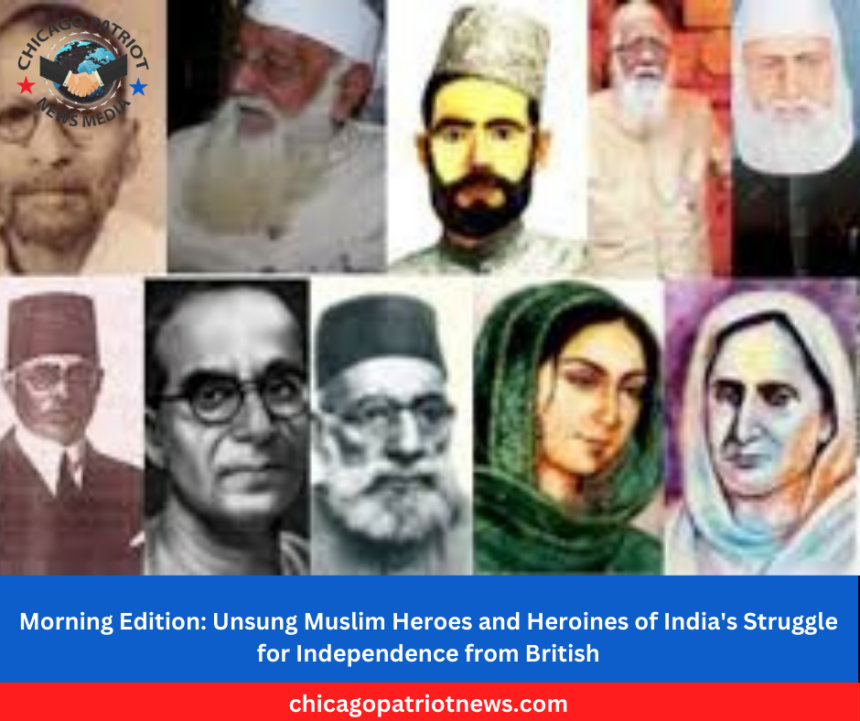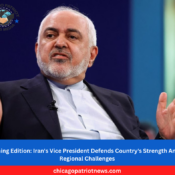Chicago – March 29, 2025
India gained independence from British rule on August 15, 1947, a significant day that occurred almost 75 years ago. It was the result of a number of movements and conflicts that raged all through the period of British administration, including the famous uprising of 1857. Gandhi, Jawaharlal Nehru, Vallabhai Patel, Abdul Ghaffar Khan, Maulana Azad, and others were among the prominent figures. Pritilata Waddedar, Kasturba Gandhi, Vijaya Lakshmi Pandit, and Sarojini Naidu were among the female leaders who encouraged Indian women to become free and take part in the freedom struggle. Since Muslims participated in the freedom movement in greater numbers. The “First Indian freedom struggle” was organized and led by Moulavi Ahamadullah Shah. Ashfaqulla Khan, who was the first person to be hanged at the age of 27 for plotting against the British Raj. Shah Nawaz Khan served in the Indian National Army (INA) as a Chief Officer and Commander in addition to being a politician.
Currently, Indian Muslims face discrimination and their patriotism is questioned. Communal parties attempt to rewrite history by omitting Muslims. Through social media, misleading information about Indian Muslims is propagated in an anti-Muslim manner. Muslim sacrifices during the cause for Indian independence are actually hidden. A brief glimpse at history, however, would show that Indian Muslims not only contributed significantly to the liberation struggle but also gave their lives in the service of the anti-colonial national battle. 61945 of the 95300 names of independence fighters mentioned on India Gate in Delhi are Muslim names, indicating that 65% of all liberation fighters were Muslims.
Muslim Vellori
Muslim Vellori, a lesser-known freedom warrior, played a significant part in social work in addition to the freedom movement. Although many people do not know Muslim Vellori’s name today, an older generation of Bangaloreans, particularly Muslims in the city, remember him with a sense of respect because he was a brave freedom warrior.
Captain Abbas Ali
Since his school days, Abbas Ali has been influenced by the revolutionary principles of Bhagat Singh. He also took part in a protest march on March 25, 1931, at Khurja to oppose Shaheed Bhagat Singh’s death sentence. Soon after Bhagat Singh was hanged, he joined the Naujawan Bharat Sabha, which Bhagat Singh had founded, and actively took part in its operations while he was still in school. He joined the All-India Students Federation (AISF), a student branch of left-leaning parties founded in 1936, after being inspired by Muhammad Ashraf. He enlisted in the Azad Hind Fauj, also known as the Indian National Army (INA). He was an important part of the INA’s Dilli Chalo campaign in 1945, which was directed by Netaji Subash Chander Bose. He engaged in combat with the Indian Army in Arakaan, but he was captured among 60000 other INA forces and was later court-martialed and given a death sentence. After Independence in 1947, he was released by the Nehru Government then he joined mainstream politics.
Allama Fazl e Haq Khairabadi
The Indian mutiny of 1857 had the most active involvement from Allama Fazl e Haq Khairabadi. In May 1857, he arrived in Delhi. On May 11, 1857, the rebel army defeated the small British force in Delhi, and Bahadur Shah, the final Mughal ruler, who had been crowned ruler, became the focal point of insurgent activity. Allama Fazl e Haq Khairabadi also took part in dialogues with Bahadur Shah Zafar and gave him counsel, according to the daily journal of Munshi Jiwan Lal, the British spy at Red Fort. On 30 January 1859, he was arrested from his house and he was sentenced to life imprisonment in the Andaman Penal Settlement and had been hanged.
Sharfuddin Quadri
He joined the Indian independence movement in 1930, during the Salt Satyagraha movement. He was held in the same cell as Mahatma Gandhi and ably assisted him in every struggle. As his son Manzar Sadique said: “My father was imprisoned with Gandhiji by the British in Cuttack. He would accompany him everywhere during the Civil Disobedience Movement “.
Maulana Mazharul Haque
In 1906, he returned to Patna to practice law. He started taking part in the struggle for liberation and rose to the position of vice chairman of the Bihar Congress Committee. He significantly contributed to the success of the Champaran Satyagraha, the Khilafat and Non-Cooperation Movements. Before his death in January 1930, he donated every last bit of his property to promote education.
Abdur Rahiiman
He studied at Madras and Aligarh universities, but he left Aligarh University early to get involved in the Khilafat and Non-Cooperation movements. He was renowned for his bravery in reestablishing order in the 1921 riot-affected districts as Sahib was jailed for two years after the 1921 Moplah Riots, although he was crucial in regaining peace. Additionally, in 1930, he took part in the Salt Satyagraha at Calicut Beach, for which he was sentenced to nine months of solitary confinement and jailed at the Central Jail in Kannur. He organized the Muslim populace against the Muslim League Party’s two-nation policy. Muhammad Abdul Rahman Sahib joined the All-India Forward Bloc that Subhas Chandra Bose organized. He was imprisoned by the British Raj from 1940 to 1945 after the Second World War broke out. Following his release from confinement, he went back to Calicut and began taking an active part in Congress activities.
Moulvi Ahmadullah Shah Faizabadi
He was known as the Lighthouse of Rebellion. He was given the appellation Moulvi because of his spiritual wisdom. He studied other academic subjects and gathered martial arts instruction. The Nizam, Nawab of Hyderabad, urged Moulvi Ahmadullah Shah to travel to England, Iraq, Iran, Makkah, and Madina. Moulvi Ahmadullah was drawn to the Sufi philosophy after returning to India, and he joined the ‘Quadri’ silsila and became Syed Furkhan Ali Shah’s disciple. In the First War of Indian Independence in 1857 Moulvi Ahmadullah engaged the forces against the East India Company, defeating them on multiple occasions. In the first struggle for independence, Moulvi Ahmadullah took part in a number of engagements alongside Khan Bahadur Khan, Firoz Shah, Begum Hazarat Mahal, and Sardar Hikhmatullah. British historian G.B. Malleson describes Maulvi Ahmedullah Shah of Faizabad as one of the greatest heroes of the First War of Independence (1857). A reward of Rs. 50,000 was offered by the East India Company for catching Moulvi Ahmadullah, alive or dead. When the Maulvi traveled to Powen to invite Jagannath Sinha to join the First War of Independence, the selfish brother of Jagannath Sinha shot the Maulvi.






